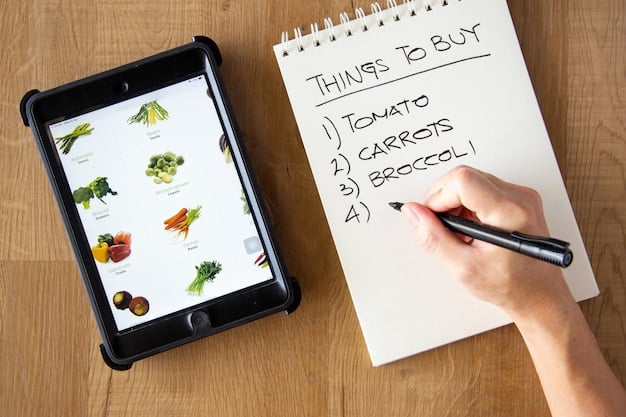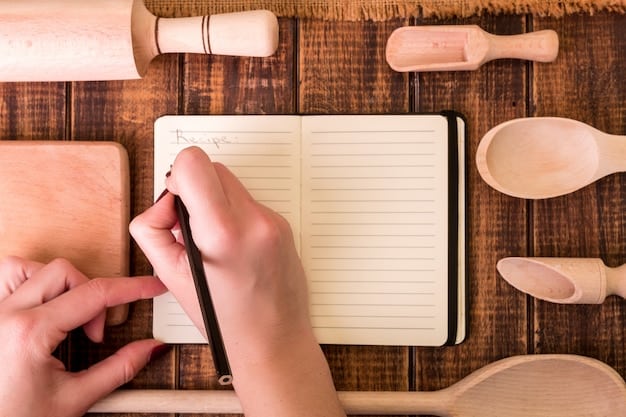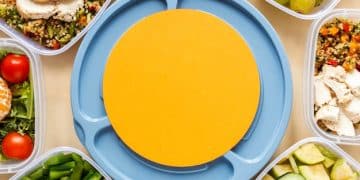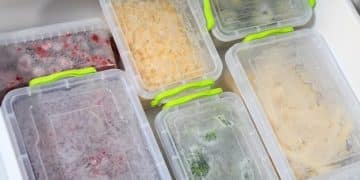Create a Meal Planning Binder: Your Organized Guide

Creating a meal planning binder is an effective way to organize your meal plans, recipes, and grocery lists, helping you stay on track and save time and money.
Do you ever feel overwhelmed trying to decide what to cook each week? A meal planning binder can be your secret weapon to staying organized and on track with your meals, making dinner time stress-free.
Why You Need a Meal Planning Binder
A meal planning binder isn’t just about writing down what you’ll eat; it’s about creating a system that saves you time, reduces food waste, and makes cooking more enjoyable. It’s a centralized location for all things meal-related.
Saves Time and Reduces Stress
No more last-minute grocery runs or frantic searches for recipes. With a meal planning binder, everything is at your fingertips. You’ll have a clear plan for the week, which can significantly reduce decision fatigue.
Reduces Food Waste
Planning your meals ahead of time helps you buy only what you need, minimizing the chances of food spoiling in your fridge. You’ll be amazed at how much money you can save by reducing waste.
Promotes Healthier Eating
When you plan your meals, you’re more likely to make healthier choices. You can incorporate more fruits, vegetables, and whole grains into your diet, setting yourself up for success.
Ultimately, a meal planning binder helps you take control of your kitchen and your health. It’s a simple yet powerful tool that can transform your approach to meal preparation.

Essential Components of a Meal Planning Binder
To create an effective meal planning binder, you need to include several key components. These will help you organize your meals, recipes, and grocery lists efficiently.
Calendar and Weekly Meal Plans
Start with a calendar where you can plan your meals for the week. This is the heart of your binder. Write down what you’ll eat for breakfast, lunch, and dinner each day.
Recipe Section
Include a recipe section where you can store your favorite recipes. Organize them by category (e.g., chicken, pasta, vegetarian) to make it easy to find what you’re looking for.
Grocery Lists
Keep a running grocery list in your binder. As you plan your meals, add items to the list. This ensures you have everything you need when you go to the store.
- Recipe Templates: Include blank recipe templates to write down new recipes or variations of old ones.
- Budget Tracker: Monitor your spending on groceries to stay within your budget.
- Inventory Lists: Keep track of what you have in your pantry and freezer to avoid buying duplicates.
By including these essential components, your meal planning binder will become an indispensable tool in your kitchen.
Setting Up Your Meal Planning Binder: Step-by-Step
Now that you know what to include, let’s walk through the steps of setting up your meal planning binder. This process will help you create a system that works for you and your family.
Gather Your Supplies
You’ll need a binder, dividers, paper, pens, and any other supplies you want to include, such as sheet protectors or stickers. Choose a binder that is durable and easy to carry.
Create Your Sections
Use dividers to create sections for your calendar, recipes, grocery lists, and other components. Label each section clearly to make it easy to find what you need.
Fill in Your Calendar
Start by filling in your calendar with any important dates or events that might affect your meal plans. Then, begin planning your meals for the week, taking into account your schedule and preferences.

Setting up your binder is a personal process. Take the time to customize it to your needs and preferences. The more personalized it is, the more likely you are to use it.
Customizing Your Meal Planning Binder to Fit Your Needs
The beauty of a meal planning binder is that it can be customized to fit your unique needs and preferences. Here are some ideas to make your binder work even better for you.
Theme Nights
Assign theme nights to different days of the week (e.g., Meatless Monday, Taco Tuesday). This can help you narrow down your options and make meal planning easier.
Family Favorites
Create a list of family favorite meals that you can easily rotate into your meal plans. This ensures that everyone will enjoy at least some of the meals each week.
Seasonal Recipes
Incorporate seasonal recipes into your meal plans. This can help you take advantage of fresh, local produce and add variety to your diet.
- Color-Coding: Use different colored pens or highlighters to categorize recipes or mark important dates.
- Sticker System: Use stickers to mark meals that are quick and easy to prepare or that use up specific ingredients.
- Inspirational Quotes: Add inspirational quotes about cooking or healthy eating to keep you motivated.
By customizing your meal planning binder, you can create a system that truly works for you and your family. The more personalized it is, the more effective it will be.
Tips for Maintaining Your Meal Planning Binder
Once your meal planning binder is set up, it’s important to maintain it to keep it effective. Here are some tips to help you stay on track.
Regular Updates
Update your binder regularly, adding new recipes, adjusting your calendar, and updating your grocery lists. This ensures that your binder stays current and relevant.
Review and Reflect
Take time to review your meal plans and reflect on what worked and what didn’t. This can help you identify areas for improvement and make your meal planning even more effective.
Make it a Habit
Make meal planning a regular habit, setting aside time each week to plan your meals and update your binder. The more consistent you are, the easier it will become.
Consistency is key to making your meal planning binder work for you in the long term. Make it a part of your routine, and you’ll see the benefits in no time.
Troubleshooting Common Meal Planning Challenges
Even with a well-organized meal planning binder, you may encounter some challenges along the way. Here’s how to troubleshoot some common issues.
Lack of Time
If you’re short on time, focus on planning just a few meals each week or try batch cooking on the weekends. This can help you save time during the week.
Picky Eaters
If you have picky eaters in your family, involve them in the meal planning process. Let them choose some of the meals, and be open to trying new things.
Unexpected Events
Be flexible and willing to adjust your meal plans if unexpected events arise. Keep some easy-to-prepare meals on hand for those occasions.
By addressing these common challenges, you can ensure that your meal planning binder remains a valuable tool in your kitchen.
| Key Point | Brief Description |
|---|---|
| 🗓️ Weekly Planning | Allocate time each week to plan meals and update your binder. |
| 🍱 Recipe Organization | Keep recipes organized by category for easy access and planning. |
| 🛒 Smart Shopping | Use your meal plan to create focused grocery lists and reduce waste. |
| 💡 Customization | Tailor your binder to fit your unique needs, preferences, and dietary requirements. |
Frequently Asked Questions
▼
A meal planning binder helps save time, reduce food waste, promote healthier eating, and reduce stress related to meal preparation. It centralizes all your meal-related information.
▼
Include a calendar, weekly meal plans, recipe section, grocery lists, recipe templates, budget tracker, and inventory lists to keep everything organized and efficient.
▼
Gather needed supplies, create sections using dividers, fill in your calendar with important dates, and start planning meals based on your schedule and preferences.
▼
Customize by assigning theme nights, creating a list of family favorites, incorporating seasonal recipes, using color-coding, or adding stickers and inspirational quotes.
▼
Update regularly, review meal plans, reflect on what works and what doesn’t, and make meal planning a regular habit to ensure your binder remains effective over time.
Conclusion
Creating a meal planning binder is a straightforward yet highly effective way to organize your meals, reduce stress, and save time. By following the steps outlined in this guide, you can create a personalized system that fits your unique needs and preferences, making meal planning a breeze.





